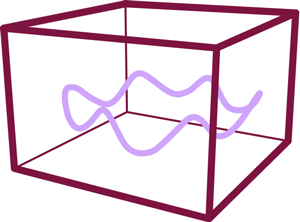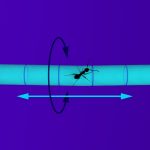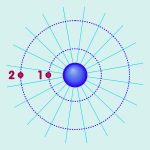Relativity and the Quantum / Elementary Tour part 5: Superstrings and universal harmony
If you go by the number of researchers involved in it, string theory is the most actively studied candidate for a theory of quantum gravity. String theory is descended from the ordinary models of particle physics, but with a crucial difference: Its basic constituents are not point-like particles, but one-dimensional objects – strings.
Strings can do what point particles cannot: They can oscillate in intricate patterns, as sketched in the following animation:

Strings
One basic postulate of string theory is that the plethora of possible oscillatory states of a string is responsible for the variety of different elementary matter and force particles that occur within the standard model of particle physics. Put simply: there is only one species of string, but depending on how this tiny string oscillates, it acquires the same properties as an electron, a photon, a specific kind of quark or some other elementary particle. It can be shown quite generally that one of the possible oscillation states of a string will automatically correspond to the properties of a graviton – a carrier particle of the gravitational force – but without any of the attendant difficulties that arise from trying to include gravity in the ordinary quantum theories of forces. This makes string theory a natural candidate for a quantum theory of gravity, and much more. String theory promises nothing less than a complete unified description of all forces and all matter particles – the whole world as a consequence of the harmony of strings.
However, this promise comes with a price attached. For instance, in order for string theory to be consistent, space must have six or even seven space dimensions in addition to the three we know from everyday life. There are several possible explanations for why we don´t see these extra dimensions: They could be “rolled up” in a complicated way, or it could be that we live on what string theorists call a “brane” – a three-dimensional space embedded into a higher-dimensional space just as a two-dimensional surface like that of the earth is embedded into ordinary, three-dimensional space.










